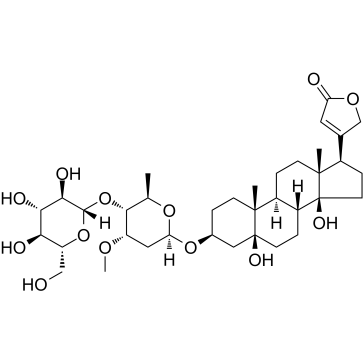13137-64-9
| Name | 3-[(3S,5S,10R,13R,14S,17R)-3-[(2R,5R)-6-[[(3R,6S)-4,6-dihydroxy-2-methyloxan-3-yl]oxymethyl]-3,5-dihydroxy-4-methoxyoxan-2-yl]oxy-5,14-dihydroxy-10,13-dimethyl-2,3,4,6,7,8,9,11,12,15,16,17-dodecahydro-1H-cyclopenta[a]phenanthren-17-yl]-2H-furan-5-one |
|---|---|
| Synonyms |
Card-20(22)-enolide, 3-[(2,6-dideoxy-4-O-β-D-glucopyranosyl-β-D-ribo-hexopyranosyl)oxy]-5,14-dihydroxy-, (3β,5β)-
Glucoperiplocymarin corchorusoside C (3β,5β)-3-{[2,6-Dideoxy-4-O-(β-D-glucopyranosyl)-β-D-ribo-hexopyranosyl]oxy}-5,14-dihydroxycard-20(22)-enolide (3β,5β)-3-{[2,6-Dideoxy-4-O-(β-D-glucopyranosyl)-β-D-ribo-hexopyranosyl]oxy}-5,14-dihydroxycard-20(22)-enolido(2-) Periplogenin + D-cymarose + D-glucose [German] periplocin Periplogenin + D-cymarose + D-glucose Periplocoside |
| Description | Periplocin is a cardiotonic steroid isolated from Periploca forrestii. Periplocin promotes tumor cell apoptosis and inhibits tumor growth. Periplocin has the potential to facilitate wound healing through the activation of Src/ERK and PI3K/Akt pathways mediated by Na/K-ATPase[1][2]. |
|---|---|
| Related Catalog | |
| Target |
Apoptosis[2] |
| In Vitro | Periplocin (5-20 μM; 48 hours; L929 cells) treatment shows increased proliferation up to 131% at 20 μM[1]. Periplocin (5-20 μM; 30-120 minutes; L929 cells) increases phosphorylation of Src, ERK, PI3K and Akt at active sites in a dosedependent and time-dependent manner.Periplocin (5-20 μM; 48 hours) significantly promotes migration of fibroblast cell[1]. Periplocin (5-20 μM; 48 hours) increases collagen production in L929 fibroblast[1]. Periplocin induces Na/KATPase mediates the activation of Src/ERK and PI3K/Akt pathways[1]. Cell Viability Assay[1] Cell Line: L929 cells Concentration: 5 μM, 10 μM, 20 μM Incubation Time: 48 hours Result: Showed increased proliferation up to 131% at 20 μM. Western Blot Analysis[1] Cell Line: L929 cells Concentration: 5 μM, 10 μM, 20 μM Incubation Time: 30 minutes, 60 minutes, 120 minutes Result: Increased phosphorylation of Src, ERK, PI3K and Akt at active sites in a dosedependent and time-dependent manner. |
| In Vivo | Periplocin (5-20 mg/kg; intraperitoneal injection; daily; for 14 days; female SCID mice) treatment represses the growth of hepatocellular carcinoma (HCC) in xenograft tumor model in mice[2]. Animal Model: Female SCID mice (6-8 weeks old) injected with Huh-7 cells[2] Dosage: 5 mg/kg, 20 mg/kg Administration: Intraperitoneal injection; daily; for 14 days Result: Repressed the growth of hepatocellular carcinoma (HCC) in xenograft tumor model in mice. |
| References |
| Density | 1.4±0.1 g/cm3 |
|---|---|
| Boiling Point | 877.4±65.0 °C at 760 mmHg |
| Melting Point | 205°C |
| Molecular Formula | C36H56O13 |
| Molecular Weight | 682.795 |
| Flash Point | 272.8±27.8 °C |
| Exact Mass | 682.356445 |
| PSA | 193.83000 |
| LogP | -1.36 |
| Vapour Pressure | 0.0±0.6 mmHg at 25°C |
| Index of Refraction | 1.624 |
| Storage condition | 2-8C |
CHEMICAL IDENTIFICATION
HEALTH HAZARD DATAACUTE TOXICITY DATA
|

